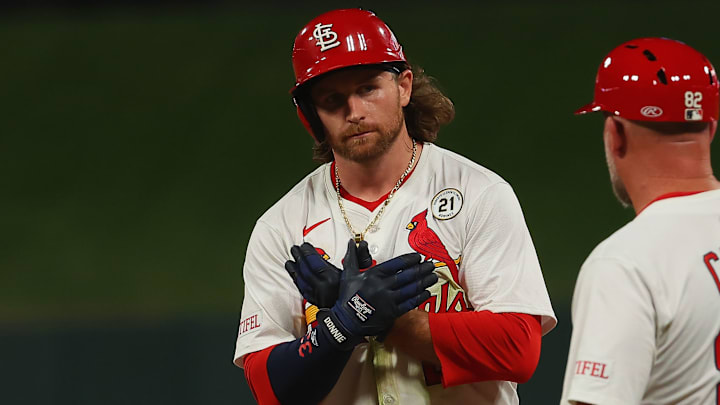The NL Central has never really been a place where neighbors do each other many favors, but this winter that reality feels especially cruel for the Milwaukee Brewers. As front offices scan a thin free-agent board and a trade market heavy on “maybe” fits, one of the cleanest answers to a few of the Brewers’ biggest questions seems to live right down the road in St. Louis.
The Cardinals are listening to pieces that would slot perfectly into Pat Murphy’s lineup card in Milwaukee (versatile bats, established stars, even a middle-of-the-order anchor), and yet the Brewers might as well be operating in a different league. Geography and rivalry still matter, and in this case, they might matter more than roster fit or need.
Brewers’ best answers at multiple positions might be hiding on the Cardinals’ depth chart
That’s the tension baked into this offseason. The Brewers aren’t chasing a teardown; they’re trying to defend their place atop a division they joined back in 1998, when realignment pushed them into the National League and into a new long-term measuring stick. Since then, Milwaukee and St. Louis have spent 27 seasons sharing a division and a lot of meaningful games.
What they haven’t shared very often is talent. The Cardinals shifted from the old NL East into the brand-new NL Central in 1994, and over the decades that followed, the relationship between the two clubs has looked far more like a cold war than a trading partner pipeline, especially with the added history of the 1982 World Series. It’s one thing to lose a deal to a team in another time zone; it’s another to watch that player beat you 13 times a year.
The track record reinforces that hesitation. Since the Brewers moved into the NL Central, the two franchises have only managed to complete five trades. The most recent came at the 2015 deadline, when St. Louis brought in veteran reliever Jonathan Broxton and cash while sending minor league outfielder Malik Collymore back to Milwaukee.
Two years earlier, the Brewers flipped John Axford to the Cardinals in a smaller but still notable swap. That’s the pattern: fringe upgrades, bullpen patchwork, marginal moves around the edges of a roster. When it comes to impact players, both sides have generally decided they’d rather deal with anyone else.
This winter, that dynamic feels especially frustrating from a Brewers perspective because the Cardinals are exactly the kind of seller Milwaukee wishes they could call. The name drawing the most oxygen so far has been Brendan Donovan, the kind of Swiss Army knife every contender covets. He’s already been linked to clubs like the Royals, Guardians, and Astros, and more suitors are expected to circle. A player with his defensive flexibility and on-base ability would slide beautifully into the Brewers’ roster puzzle, giving them coverage at multiple spots and lengthening the lineup. His projected 2026 salary — estimated in the mid-$5 million range by MLB Trade Rumors — only adds to the appeal for a mid-market team that has to obsess over every dollar of surplus value.
And Donovan is just the start of what St. Louis could theoretically offer. Six Cardinals showed up on MLB Trade Rumors’ list of top trade candidates this offseason, a group that includes three established, big-ticket veterans: Sonny Gray, Nolan Arenado, and Willson Contreras. On paper, that’s a menu that answers several Brewers needs in one place. Arenado, even past his peak, is still the kind of strong defensive, run-producing third baseman who would upgrade Milwaukee’s infield and add postseason experience.
Gray remains a rotation topper when healthy. Contreras, now more of a first baseman/designated hitter hybrid, brings power that would immediately raise the lineup’s ceiling and, in the wildest version of this, would share a lineup card with his brother William in Milwaukee — a concept that feels more like a video game fever dream than a realistic call between division rivals. Cardinals ownership has even signaled a willingness to include cash to move some of those larger contracts, and the veterans with no-trade clauses have reportedly softened their stances compared to last winter.
If those players were wearing almost any other uniform outside of the NL Central, the Brewers would at least be in the conversation. Instead, they’re stuck watching from the other side of the division, knowing that even a perfectly fair offer is unlikely to move the needle if it strengthens a rival. That’s the reality of life in the NL Central: Milwaukee can admire the fit, sketch out the hypotheticals, and maybe even privately wish the Cardinals did more business inside the division — but wishing doesn’t get you a phone call back.
